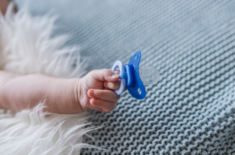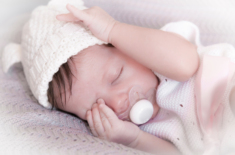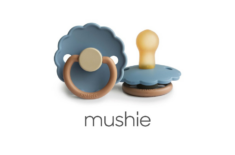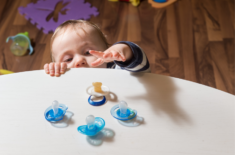Is A Pacifier Good For Babies?
Studies show that pacifiers or soothers can reduce the risk of sudden infant death syndrome (SIDS). (1)(2)
Considering that as many as 37% of unexpected infant deaths are due to SIDS, it’s surprising to learn that something as simple or inexpensive as a pacifier can help prevent it. (3)
That’s one of the reasons why the AAP (American Academy of Pediatrics) and the AAFP (American Academy of Family Physicians) both recommend pacifier use for babies. (4)
For us parents, that’s certainly some good news, right?
However, while the AAP and AAFP encourage pacifier use for the first six months of life, they also acknowledge that it can also have risks and lead to possible complications, especially with prolonged use.
What are the risks of prolonged pacifier use? How many hours should your baby use a pacifier, and can newborns sleep with one? Should you remove the pacifieronce your baby is asleep? What factors should you consider in finding the best pacifier for your baby? Find out below.
Benefits: Why Are Pacifiers Used?
Sucking is one of your newborn baby’s normal reflexes. These involuntary movements can help them find nourishment from breastfeeding or a formula bottle.
As many as 90% of newborn babies might show some signs of trying to suck their thumbs or hands as early as two hours after birth. (5)
Of course, you can’t feed them all the time they want or need to suck. That’s where a pacifier can come in handy.
If your little one wants to suck on something in between feedings, they naturally find their thumbs to soothe themselves. However, thumbsucking can turn into a habit that could affect your child’s teeth.
Pacifier use can offer contentment between feeds but might be an easier habit to break than thumbsucking because they’re disposable. (5)
The following are some of the possible benefits of using a pacifier:
- It might soothe a fussy baby. Some babies are happy when they’re sucking on something.
- It can help your baby fall asleep.
- It might provide a temporary distraction during vaccinations, certain medical procedures, and similar situations.
- Sucking a pacifier can help ease discomfort or ear pain during flights or high-altitude trips.
- It can assist tube-fed preterm babies in learning how to use a bottle. (6)
Can Newborns Sleep With A Pacifier?
Yes. It can help save your newborn baby from SIDS. However, don’t attach things like ribbons or ties to your baby’s pacifier because that can increase strangling risks. (1)(2)
Can A One-Month-Old Baby Use A Pacifier?
Although the situations can vary, breastfeeding can be established when your baby is around three or four weeks old.
When they’ve settled into their nursing routine, you can try offering them a pacifier.
Like other baby products, it’s nice to get your pediatrician involved in deciding about your baby’s pacifier use.
They can offer valuable advice on which paci can be best for your baby’s needs, plus other important information about using this simple but potentially life-saving little thing.
How Many Hours Should My Baby Use A Pacifier?
There aren’t specific limits to how many hours your baby should use a pacifier.
However, the AAP and the AAFP both recommend weaning your baby from pacifiers starting when they’re six months of age. It can help reduce the risk of ear infections. (4)
Do Doctors Recommend Pacifiers?
The AAFP (The American Academy of Family Physicians) recognizes pacifiers’ many potential benefits and disadvantages. (4)
Many of them agree that the benefits, especially SIDS prevention, can outweigh the risks.
However, doctors can also have different professional opinions about pacis and binkies. Your pediatrician can provide valuable information and advice on what you should do.
Some Questions To Ask Your Doctor
“Does my baby need a pacifier?”
“Will the hospital give my little one a pacifier at birth?”
“How long should I wait before giving a pacifier to my baby?”
“Do you think a pacifier is safe?”
“What other ways should I try to help soothe my crying baby?”
Potential Drawbacks Of Using A Pacifier
While a pacifier’s functionality is admirable, it can also have some potential drawbacks that are worth considering before introducing them to your baby.
Nipple Confusion & Breastfeeding Disruption
Despite many baby bottles and pacifiers trying to mimic human breasts, most babies can tell the difference.
It can lead to breastfeeding disruption, nipple confusion, and other feeding troubles.
A 2015 study in the Journal of Perinatology showed that bottle-feeding could be more likely to cause nipple confusion than pacifier use. (7)
Still, most pediatricians recommend waiting until breastfeeding is well established before introducing your baby to a pacifier or binky.
Pacifier Dependence
Yes, pacifiers can soothe your baby in between feeds, but dependence on a soother can also have its drawbacks.
For example, you might regularly wake up to middle-of-the-night crying spells because your baby’s pacifier fell and they can’t find it anymore.
One way to prevent this is to limit pacifier use to a few hours a day, though you can also opt to leave multiple pacifiers in your baby’s crib. Their hands can instinctively find it while they’re sleeping.
Dental Problems
The AAFP doesn’t recommend the extended use of pacifiers if your child is over four years old. Prolonged use beyond this age can cause your child’s teeth to be misaligned and other dental problems. (4)
According to 2006 research published in the International Journal of Orthodontics (Milwaukee), children who still use pacifiers over the age of three might be more likely to develop misaligned teeth. (8)
Ear Problems
Numerous studies have found a link between pacifier use and acute otitis media (middle ear infection). (9)(10)
Babies and young children who use pacifiers might be twice more likely to develop ear infections than those who don’t. (9)
Researchers also discovered that ear infection risk could be reduced by 33% with limited pacifier use. It applies to children under 18 months of age. (11)
Baby Pacifier Do’s And Don’ts
If you decide to offer your baby a pacifier, these tips can come in handy to reduce safety risks:
Do’s
- Wait until your baby gets the hang of breastfeeding before giving them a pacifier. The sucking mechanism is different. So, starting with a pacifier too early could interfere with successful breastfeeding.
- Offer the pacifier last.
- Try other ways to calm your baby, like rocking, cuddling, singing, or simply picking them up before offering a pacifier. Giving them a binky might quickly soothe them, yet it can also make you miss the underlying reason (hungry, sleepy, wet diaper, tummy ache, etc.) why they’re being fussy.
- Check if your baby is hungry or might need a diaper change before offering a pacifier.
- Let your infant set the pace. If they want a pacifier, you can give it to them. If they aren’t interested, don’t force them to use one.
- Pick a pacifier with a shield wider than your baby’s mouth. It can help reduce choking risks. But also make sure the shield has a hole to avoid suffocation.
- Use the right pacifier size for your baby’s age and size. Tiny newborn pacifiers without shields can be a choking risk to older kids.
- You can opt for one-piece pacifiers because multiple-piece pacifiers could break and become choking hazards.
- Choose a sterilizer and dishwasher-safe variety for easy cleaning.
- Keep your baby’s pacifiers clean. Frequently wash and sterilize pacifiers, especially for younger ones. Babies six months of age and younger are more prone to infections because their immune system is still developing. (12)
- Rinse a pacifier with hot water if it falls to the ground.
- Check for signs of deterioration or cuts that can cause parts to detach and become a choking risk.
- Pacifier use isn’t recommended for children four years of age and older.
- Consider stopping pacifier use as early as six months to one year of age.
- You can also ask help from your doctor in deciding when and how your child should stop using a binky.
Don’ts
- Don’t force a pacifier into your baby’s mouth. If it falls out while they’re sleeping, leave it there as long as your baby doesn’t look for it.
- Don’t allow siblings to share pacifiers because that can transfer germs.
- Don’t “clean” pacifiers by putting them in your own mouth. It can also cause possible infections or transfer germs that can cause tooth decay.
- Don’t coat the pacifier in sugar or honey. It can cause tooth decay. Also, honey can cause botulism, a serious illness due to bacteria that can be more dangerous to babies under one year of age. (13)
- Don’t attach the pacifier to your baby’s crib, stroller playpen, stroller, or baby’s wrist or neck or wrist using a ribbon, string, or cord. These can wrap around your baby’s neck and accidentally strangle them while sleeping.
- Don’t use the baby pacifier in ways outside the manufacturer’s safety recommendations.
- Don’t use a binky as a substitute for attention or other kinds of comfort such as soothing, cuddling, rocking, or singing.
- Don’t use a soother as the first line of defense. Sometimes, changing position or a rocking session can calm a crying baby. Offer a pacifier to your baby only after or between feedings.
- Don’t use a pacifier to replace or delay meals.
- Don’t try to create a DIY pacifier. For example, a bottle nipple taped to a plastic bottle top might work as a pacifier, but it can be dangerous. The nipple can break or come apart, and the broken parts can get stuck in your baby’s throat.
What If My Baby Won’t Take A Pacifier?
Yes, a pacifier can be a tool to reduce the risk of SIDS, but you don’t need to force your baby into using one if they aren’t interested. It’s also not something to worry about.
Pacifier use isn’t the only way to reduce SIDS risk. What’s more important is providing your baby with a safe, firm mattress to sleep on. (14)
Their bed should also be free from stuffed animals, blankets, crib bumpers, or baby loungers.
How To Keep The Pacifier In Your Baby’s Mouth
You can find different pacifiers on the market, including ones that are attached to a lovey toy (a stuffed toy your baby can cuddle for comfort).
The toy can help keep the pacifier in your baby’s mouth. In theory, it also keeps the pacifier from falling to the ground because your child enjoys hugging the toy.
Pacifier clips are also great for keeping their binky from falling. However, only use these when your baby is awake because these can increase the suffocation risk.
While a pacifier has benefits, it should be a baby-led comfort device.
Only use them if your baby wants them. If your baby spits it out or turns their head away when offered one, then they’re done with pacifiers for the moment.
You can try offering a pacifier later, but never force a binky into your baby’s mouth.
Factors To Consider In Choosing Pacifiers
All pacifiers aren’t created equal. But there’s also no perfect pacifier that can suit all babies. Sometimes, it might take some tries before you can find the pacifier that your baby prefers.
The following are some of the factors you can consider in choosing a pacifier:
Material
There are materials commonly used for pacifiers:
- Silicone nipples
- Latex or rubber nipples
Silicone pacifiers can be the better choice because this material is hypoallergenic.
They are also sturdier, dishwasher safe (top rack), and don’t retain odors. However, silicone pacis might not be as soft as those made from latex.
Rubber and latex pacifiers are usually cheaper, softer, and more flexible, but they can break down easily and become sticky if heated. So, you can’t boil or sterilize them.
Also, some babies might be allergic to latex.
Symptoms of latex allergy can include the following: (15)
- Itchy skin, lips, or mouth
- Skin redness
- Hives
- Rash
- Sneezing
- Runny nose
- Wheezing
- Cough
- Itchy and/or watery eyes
- Scratchy throat
Severe cases of latex allergy can lead to: (15)
- Difficulty breathing
- Nausea
- Vomiting
- Dizziness
- A drop in blood pressure
- Loss of consciousness
- Confusion
- Rapid or weak pulse
You might notice that some pacifiers are labeled BPA-free or phthalate-free. BPA (bisphenol-A) and phthalates are linked to low IQ, altered reproductive function, diabetes, cancer, and asthma. (16)(17)
Latex and silicone don’t usually contain BPA and phthalates, but many parents check for these on the pacifier packaging as an added measure.
Size & Safety
Many manufacturers offer pacifiers in different sizes. To avoid choking risks and other safety issues, choose the ones made for your baby’s age and size.
For example, smaller pacifiers are made for newborns, but these tiny binkies can potentially be a choking risk for older children. However, newborns and babies might find larger pacifiers too big for their mouths during their first month.
You can check the packaging for pacifier size and their recommended ages.
Pacifiers with a shield can be a good choice to reduce further choking risks. The recommended shield size is at least 1½ inches across. It can prevent your baby from taking the entire pacifier in their mouth. (18)
In choosing a pacifier with a shield, look for one with ventilation holes at the sides.
These holes allow air circulation. Without them, your baby’s saliva can collect behind the base, possibly causing a skin rash or irritation.
Choosing a one-piece paci can also be a good idea because those with multiple parts can break into separate pieces, posing a choking hazard.
Style & Nipple Shape
Manufacturers create different styles to meet your baby’s needs.
For example, you’ll find different nipple shapes:
- Round – the most common option is the straight, elongated nipple, but some can also have a ball-shaped tip
- Flat – mimics the nipple shape
- Orthodontic pacifiers – can help keep your baby’s mouth in the correct position
Some pacifiers are designed to double as a teether. Others are attached to a lovey (stuffed toy) for your baby to cuddle.
Ease Of Cleaning & Disinfection
A dishwasher-safe pacifier allows easy cleaning. However, be sure to check if the pacifier is cool and there’s no water inside the nipple before giving it to your baby.
Product Recalls
It’s very important to check for recent product recalls before buying pacifiers, baby foods, or anybaby product.
For example, Mushie & Co issued a recall on all units of FRIGG silicone pacifiers (also known as Mushie pacifiers) in January 2022 over potential choking risks.
Extra Features
Some pacifiers glow in the dark so you or your baby can have an easier time finding them in the dark.
Pacifier handles also come in rings or buttons or stick-like protrusions.
There are pacifiers with nipple covers to help keep the paci clean. However, be careful if the cap is removable because the small piece can be a choking hazard.
What’s The Best Pacifier?
There’s no perfect pacifier that can be the best for all babies. However, you’ll find plenty of options with different features to suit your baby’s needs.
Here are our recommendations:
- Philips Avent Soothie Pacifier
- Dr. Brown Pacifier
- Wubbanub Pacifier with lovey (soft toy)
These are pacifiers ideal for breastfed babies but can also be good options if you’re bottle-feeding your little one.
Baby Pacifier FAQs
When Should I Replace My Baby’s Pacifier?
Thoroughly check the pacifier before giving it to your baby. Replace if:
- It doesn’t smell good
- It looks dirty
- It has holes or cuts
- It shows signs of discoloration
- There’s water inside the nipple part
- The nipple looks like it might tear off the base
Some manufacturers recommend discarding the pacifier after one month of use.
How Should I Wash A Pacifier?
Always use a mild, baby-friendly soap and rinse thoroughly with clean water. You can sterilize the pacifier, depending on the manufacturer’s instructions.
REFERENCES
(1) https://pubmed.ncbi.nlm.nih.gov/16216900/
(2) https://pubmed.ncbi.nlm.nih.gov/21505778/
(3) https://www.cdc.gov/sids/data.htm
(4) https://www.aafp.org/afp/2009/0415/p681.html
(5) https://www.hopkinsmedicine.org/health/conditions-and-diseases/thumb-sucking
(6) https://pubmed.ncbi.nlm.nih.gov/6810298/
(7) https://pubmed.ncbi.nlm.nih.gov/26181720/
(8) https://pubmed.ncbi.nlm.nih.gov/17256438/
(9) https://pubmed.ncbi.nlm.nih.gov/10436480/
(10) https://pubmed.ncbi.nlm.nih.gov/18562333/
(11) https://pubmed.ncbi.nlm.nih.gov/10969091/
(12) https://www.hopkinsallchildrens.org/Patients-Families/Health-Library/HealthDocNew/Neonatal-Infections
(13) https://www.cdc.gov/botulism/prevention.html
(14) https://www.cdc.gov/reproductivehealth/features/baby-safe-sleep/index.html
(15) https://www.mayoclinic.org/diseases-conditions/latex-allergy/symptoms-causes/syc-20374287
(16) https://www.mayoclinic.org/healthy-lifestyle/nutrition-and-healthy-eating/expert-answers/bpa/faq-20058331
(17) https://noharm-uscanada.org/issues/us-canada/phthalates-and-dehp
(18) https://www.healthychildren.org/English/safety-prevention/at-home/Pages/Pacifier-Safety.aspx











